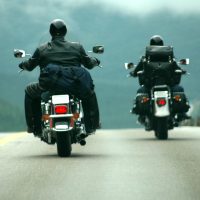Distracted Driving Series: Part Three

Anything that diverts a driver’s attention from driving can result in distracted driving. This includes eating, talking to passengers, grooming, and talking or texting on cell phones. In 2012, 3,328 people were killed in car crashes attributed to distracted driving. Another 421,000 people were injured in wrecks involving a distracted driver. Those who engage in tasks requiring visual and manual attention (like dialing or texting on a cell phone) are three times more likely to be involved in a wreck. [1] Because of the dangers inherent in distracted driving, this multi-part series will discuss how distracted driving affects different types of drivers, passengers, and pedestrians.
Distracted Driving & Motorcyclists
Driving a motorcycle requires intense mental focus, balance, and skill. And because motorcyclists are physically exposed to the elements, they are particularly vulnerable in accidents. A 2012 study showed that, per mile traveled, motorcyclists were approximately 26 times more likely than passenger car occupants to die in a crash and 5 times more likely to be injured. [2] It’s a problem that seems to be worsening, as motorcyclist fatalities increased by 33% between 2003 and 2012. As such, other distracted drivers present a special hazard to motorcycle drivers. Motorcyclists may be somewhat less likely to engage in distracted driving since they must use both hands to drive and maintain balance. While overall, motorcyclists are less likely to be using cell phones than drivers of motor vehicles, motorcyclists can still become distracted while driving. [3] Manual tasks like using a cell phone, eating, drinking, smoking, or operating a GPS or radio, present obvious risks in that they require a motorcyclist to take his hands off the handlebars. Further, motorcyclists may be especially prone to distraction as a result of weather, glare, noise, pedestrian activity, scenery, loose clothing, or unsecured luggage. Motorcyclists should be aware of these potential distractions and prepare themselves and their bikes accordingly.
To be safe, motorcyclists should always wear helmets, eye protection, and brightly colored, thick protective clothing. [4] Give yourself space and time to respond to other drivers, and to allow other drivers to see and respond to you. Never drive when you are tired, distracted, or under the influence of alcohol or drugs. Never attempt to multi-task while driving, and remember that even hands-free phones present significant distraction risks.
[1] http://www.distraction.gov/get-the-facts/facts-and-statistics.html
[2] http://www-nrd.nhtsa.dot.gov/Pubs/812035.pdf
[3] http://www-nrd.nhtsa.dot.gov/Pubs/811737.pdf
[4] http://msf-usa.org/downloads/If_you_ride_a_motorcycle.pdf


